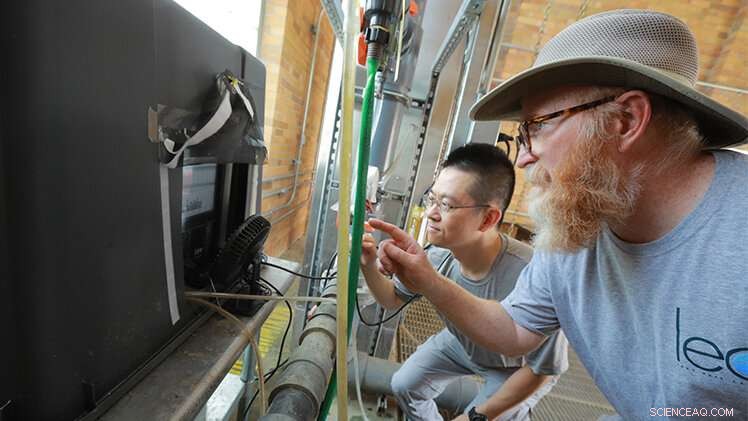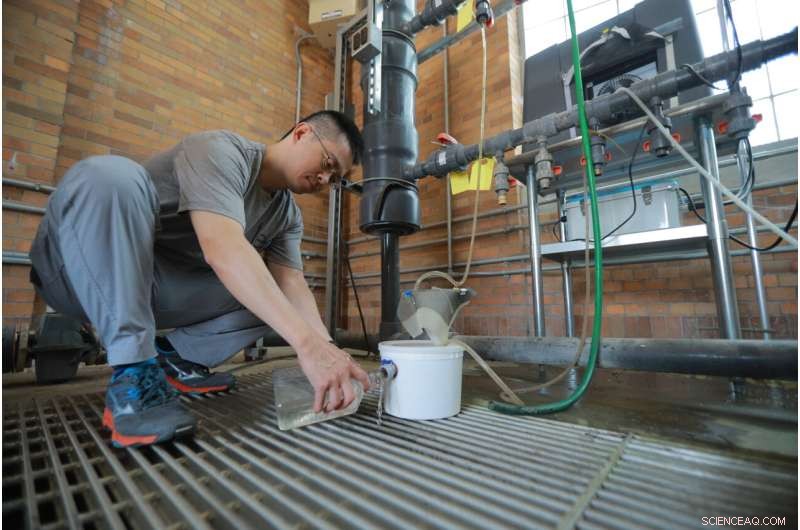
Wetenschap
Amerikaanse wetenschappers testen geavanceerde, realtime algensensor in waterzuiveringsinstallatie

Dr. Thomas Bridgeman, hoogleraar ecologie en directeur van het UToledo Lake Erie Center, rechts, en Dr. Kuo-Pei Tsai, een postdoctoraal onderzoeksmedewerker, lezen gegevens van het online algenmonitoringsysteem dat wordt getest in het ruwe water van de stad pompstation om de openbare drinkwatervoorziening te beschermen tijdens het schadelijke algenbloeiseizoen. Credit:Daniel Miller, de Universiteit van Toledo
Terwijl er wereldwijd gevaar dreigt in watermassa's waar giftige algen bloeien, kan een kleine plastic opslagkuip in Toledo die is afgesloten om te beschermen tegen spatten, spinnen en vogelpoep een baanbrekende technologie bevatten in de strijd tegen het groeiende milieuprobleem.
Algenwetenschappers van de Universiteit van Toledo testen een realtime optische sensor in de waterzuiveringsinstallatie van Toledo als onderdeel van de bronwatermonitoring om de openbare drinkwatervoorziening te beschermen tijdens het schadelijke algenbloeiseizoen.
Elke 15 minuten neemt het apparaat een slokje van het Erie-water dat de fabriek binnenkomt, leest het monster en zet de meetgegevens online zodat onderzoekers en beheerders van waterleidingbedrijven er op afstand toegang toe hebben.
De grootste waarde is het vermogen om te zien of kleine eencellige organismen, bekend als cyanobacteriën, die schadelijke algenbloei vormen in Lake Erie, fragiel zijn en beginnen open te breken. Als de cellen openbreken, geven ze toxine af. Opgelost toxine is moeilijker te verwijderen voor waterzuiveringsinstallaties omdat het door filters kan gaan en met chemische middelen moet worden verwijderd voordat het water de fabriek verlaat voor onze kranen.
Sinds juli hebben wetenschappers van UToledo de draden en slangen van het apparaat gecontroleerd om er zeker van te zijn dat het goed werkt. Ze doen ook laboratoriumexperimenten in het UToledo Lake Erie Center, waaruit blijkt dat de technologie werkt zoals verwacht.
"Ons werk deze zomer met het PhycoSens-apparaat is de eerste test van dit online algenmonitoringsysteem in een drinkwaterfabriek in de VS", zegt dr. Thomas Bridgeman, hoogleraar ecologie en directeur van het UToledo Lake Erie Center. "Als we succes boeken in de waterzuiveringsinstallatie van Toledo en in de hele regio om het vrijkomen van toxines onmiddellijk te detecteren en te melden, dan kan het landelijk worden opgeschaald. Tot nu toe is het veelbelovend."
De testimplementatie van het geavanceerde monitoringsensorsysteem maakt deel uit van een UToledo-project van 1,4 miljoen dollar, gefinancierd door het Amerikaanse legerkorps van ingenieurs, dat meer dan een jaar geleden begon en zich richt op vroege detectie en beheer van schadelijke algenbloei.
Sinds de watercrisis in Toledo in 2014 een half miljoen inwoners drie dagen lang zonder veilig kraanwater heeft achtergelaten, hebben onderzoekers meer duidelijkheid dat niet alleen de grootte en het uiterlijk van de algenbloei ertoe doet, maar ook wat er in de cellen gebeurt.
De apparaten van Bridgeman van het Duitse bedrijf bbe Moldaenke gebruiken optische sensoren om in realtime te meten hoeveel en wat voor soort algen de waterzuiveringsinstallatie binnenkomen, waaronder cyanobacteriën. Wat nog belangrijker is, de sensoren kunnen een waarschuwing geven dat de cyanobacteriëncellen openbreken en hun inhoud, inclusief eventuele giftige stoffen, in het water lekken.
"A large release of toxin can happen in a matter of hours, and it is critical for water plant operators to have this information so they can adjust their treatment levels quickly, before dissolved toxin can get through the plant," Bridgeman said. "The data are produced every few minutes, which makes it a useful early warning tool for a potentially rapidly changing algal situation."
Notable for researchers is data collected in late July showing the peak of the bloom and its decline.
"So far we have not detected any of that cell breakage at the water treatment plant or near the water intake out in the lake using the automated sensor, which is good news," Bridgeman said. "However, UToledo crews on our research vessel taking water samples out in the lake throughout Lake Erie's western basin—not near the water intake—have detected cell breakage using the manual version of the same device this season."
Bridgeman said that cell breakage events leading to large releases of dissolved toxin don't happen every year in Lake Erie.

Dr. Kuo-Pei Tsai, a post-doctoral research associate at the UToledo Lake Erie Center, works at the city's raw water pump station with the plastic storage tub containing a game-changing technology in the fight against toxic algae. Credit:Daniel Miller, The University of Toledo
"It happened in 2019 and possibly in 2014 but not to a large extent this summer, at least not near the water treatment plant's water intake out in the lake," Bridgeman said.
The Toledo Water Treatment Plant's laboratory makes the most use of the data.
"The experimental optical sensors being tested at the raw water pump station are a useful source for both the changes and the severity of algae levels coming from the lake," said Jeff Martin, chief chemist at the Toledo Water Treatment Plant. "We didn't have remote access to the data until part of the way through the bloom season due to computer issues, but since then it has been a welcome tool in treatment decisions."
Bridgeman has studied harmful algal blooms for two decades. His laboratory is one of the key locations for tracking and providing early warning of harmful algal blooms in the western basin of Lake Erie.
He said while the new instruments can detect the health, or physiological condition, of the cyanobacteria, they do not provide actual toxin readings, making them a supplemental weapon in a water utility manager's arsenal to efficiently and economically adjust treatment to maintain drinking water safety.
"Measuring toxin still requires a separate, fairly time-consuming test," Bridgeman said. "Therefore, the fast optical measurements will be coordinated with slower chemical toxin measurements to provide a complete picture of what is happening in the lake water that is entering the water plant."
The device will be removed from the water treatment plant for analysis in October and then his team will study the results and potentially put it back in the plant next summer.
Bridgeman's device monitoring tests are one part of a larger, wide-ranging project funded by the U.S. Army Corps of Engineers that also includes faculty in the UToledo College of Engineering.
Dr. Youngwoo Seo, professor of civil and environmental engineering and chemical engineering, leads the three-year project to improve water quality from the source to the tap.
Some of the technology and techniques being tested by UToledo are new to water treatment plants in the western hemisphere.
The project features two different parts working together:
- Advanced monitoring sensors and molecular genetic analyses to enhance early harmful algal bloom detection and real-time condition diagnostic capability; and
- Nature-inspired biological treatment methods coupled with algaecides to attack cyanobacteria and degrade toxins it produces.
Dr. Dae-Wook Kang, assistant professor of civil and environmental engineering, leads a molecular approach to develop a robust detection method, and his analysis will help better understand what triggers the toxin gene production of cyanobacteria.
Seo is focused on mitigation and the treatment method for toxin removal. His laboratory is working on the biological degradation of cyanobacteria and their toxins using the naturally occurring bacteria and viruses from the lake and NSF-approved chemical treatments. + Verder verkennen
Schadelijke algenbloei wordt detecteerbaar langs het westelijke Eriemeer
 Nieuwe theorie belooft een nieuwe vorm te geven aan hoe we denken over polymeersuperstructuren
Nieuwe theorie belooft een nieuwe vorm te geven aan hoe we denken over polymeersuperstructuren Manipuleren van ketenlopen in olefinen met behulp van aarde-overvloedige op ijzer gebaseerde katalysatoren
Manipuleren van ketenlopen in olefinen met behulp van aarde-overvloedige op ijzer gebaseerde katalysatoren Hoe vindt u hoeveel mol in een verbinding
Hoe vindt u hoeveel mol in een verbinding  Hoe een 3D-atoomstructuur van zwavel
Hoe een 3D-atoomstructuur van zwavel Een dag om de favoriete eenheid van scheikunde te vieren:de mol. Maar wat is een mol?
Een dag om de favoriete eenheid van scheikunde te vieren:de mol. Maar wat is een mol?
 Fossiele plantenmoleculen gebruiken om de Groene Sahara op te sporen
Fossiele plantenmoleculen gebruiken om de Groene Sahara op te sporen Enge opwarming bij palen die op rare tijden verschijnen, plaatsen
Enge opwarming bij palen die op rare tijden verschijnen, plaatsen Zeespiegelstijging kan bestaande ongelijkheden in de Bay Area verergeren
Zeespiegelstijging kan bestaande ongelijkheden in de Bay Area verergeren Zuid-Korea streeft naar koolstofneutraliteit tegen 2050:Moon
Zuid-Korea streeft naar koolstofneutraliteit tegen 2050:Moon NASA ziet tropische storm Nangka het eiland Hainan onderdompelen
NASA ziet tropische storm Nangka het eiland Hainan onderdompelen
Hoofdlijnen
- Wat veroorzaakte de gaten in SUE de T. rexs kaak? Waarschijnlijk geen infectie
- Onderzoekers ontdekken nieuwe overspraak tussen fytohormonen ethyleen en auxine
- Wat zijn enkele kenmerken van proteïne?
- Hoe tardigrades uitdroging overleven
- Afrikaanse slaapziekte:hoe de ziekteverwekker tseetseevliegen koloniseert
- Geen zoetekauw meer? Wetenschap schakelt het verlangen naar suiker bij muizen uit
- Het verschil tussen glycolyse en gluconeogenese
- Is maretak meer dan alleen een excuus voor een kus?
- Inktvissen horen boeggolf van dreigend gevaar
- Comcast-bod op Fox volgt na gunstige uitspraak van AT&T

- Sensing-technologie kan de precisie van machine learning voor productie verbeteren, elektrische voertuigen, slimme huizen

- Autofabrikanten dringen er bij Californië op aan, VS hervatten gesprekken over kilometers

- NASA bestudeert ruimtetoepassingen voor GaN-kristallen

- AT&T beboet $ 60 miljoen voor misleiding met onbeperkte abonnementen

 Hoe de inverse van een percentage te krijgen
Hoe de inverse van een percentage te krijgen Meer rendement op retargetingcampagnes voor e-commerce
Meer rendement op retargetingcampagnes voor e-commerce De declinatie van de zon berekenen
De declinatie van de zon berekenen Hoe een DC-spanningsregelaar te maken
Hoe een DC-spanningsregelaar te maken Onderzoekers ontdekken gevaren van vervuiling binnenshuis
Onderzoekers ontdekken gevaren van vervuiling binnenshuis Van marginale landbouwgronden winst maken voor boeren en ecosystemen
Van marginale landbouwgronden winst maken voor boeren en ecosystemen NASA's Dragonfly Rotorcraft om Saturnus Gigantische Maan Titan te verkennen
NASA's Dragonfly Rotorcraft om Saturnus Gigantische Maan Titan te verkennen  Wetenschappers ontwikkelen nieuwe verbinding die beide soorten antibioticaresistente superbacteriën doodt
Wetenschappers ontwikkelen nieuwe verbinding die beide soorten antibioticaresistente superbacteriën doodt
- Elektronica
- Biologie
- Zonsverduistering
- Wiskunde
- French | Italian | Spanish | Portuguese | Swedish | German | Dutch | Danish | Norway |

-
Wetenschap © https://nl.scienceaq.com

